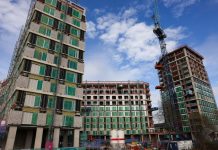In the first half of 2017 a total of 16.5million sq ft of logistic and industrial units above 50,000 sq ft was acquired for occupation, 2% up on H1 2016, according to the latest research from Knight Frank. Whilst this is 24% below the level of take-up in H2 2016, it is, however, above the 5 year average.
Charles Binks, Head of Logistics and Industrial, Knight Frank commented: “Given the snap General Election and ongoing uncertainty surrounding Brexit, these figures are particularly encouraging, especially when taking into account supply and availability continue to decline and land available for industrial/logistics development remains in short supply particularly in Greater London, where land continues to be lost to other higher value uses. The outlook for the occupier market for the second half of 2017 is mixed, given the economic slowdown, increasing affordability issues beginning to constrain rental growth; however, slowing demand is masked by the lack of stock.
Underlying trends driving the market are the shift to online retailing and the move to urban logistics although we have seen a surge in take up by manufactures. Internet sales are continuing to rise and now account for around 15% of all retail sales in the country.
The Midlands continued to dominate the market, with 32% of total take-up coming from this area, followed by the North West and London & the South East, which together accounted for a further 30% of take-up. Pre-lets represented a significant proportion of deals, with 35% of UK wide take-up of units over 50,000 sq ft in this category in H1 2017.
On the investment side, investor demand for logistics assets remains strong, buoyed by the sector’s favourable underlying demand and supply conditions, and income generating attributes. £3.2bn worth of industrial property assets changed hands during H1 2017. This compares with £2.9bn over the previous six months, representing an increase of 13%.
Johnny Hawkins, Partner, UK Capital Markets commented: “On the investment side, there have been more large deals since the start of the year, although the number of transactions are down on H2 2016, with 227 industrial transactions recorded in H1 2017, compared with 300 in H2 2016. We’ve also seen that overseas investors and property companies have been the major players so far this year accounting for 34% and 31% respectively, of total investment activity over H1 2017. UK institutions accounted for an additional 25%.”
The Industrial sector has performed particularly well with the annual rate of capital value growth escalating to 6.2% in June. Industrial rental value growth continues to exceed inflation with an annual rental value growth of 3.8% in June 2017. In terms of the wider market, industrials continue to outperform the other two core sectors, with London and the South East leading the way.
Positive market sentiment for the industrial sector has contributed to steady yield compression. The IPD All Industrial Equivalent Yield stood at 6.16% in June, 29 bps down since the start of the year, and the lowest on record since October 2007. While Yields between prime and secondary assets are still narrow by historic standards, with single-let distribution yields at 4.50%, and prime multi-let and secondary estates at 5.25% and 6.75%, respectively, demonstrating the on-going demand for this sector.























